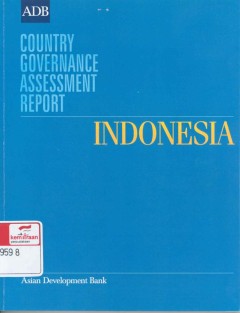Filter by
Found 12368 from your keywords: subject="Criteria and Theory i...

Himpunan Peraturan Dan Keputusan Komisi Pemilihan Umum Nomor 03-04-05-06-07-0…
- Edition
- -
- ISBN/ISSN
- -
- Collation
- -
- Series Title
- Peraturan Pemilihan Umum
- Call Number
- R324 KOM h
- Edition
- -
- ISBN/ISSN
- -
- Collation
- -
- Series Title
- Peraturan Pemilihan Umum
- Call Number
- R324 KOM h

Almanak anggota parlemen RI 2004-2009
- Edition
- 1st print
- ISBN/ISSN
- 979-25-4160-8
- Collation
- viii, 891p.; 27 cm
- Series Title
- -
- Call Number
- R328.598, CEN, a
- Edition
- 1st print
- ISBN/ISSN
- 979-25-4160-8
- Collation
- viii, 891p.; 27 cm
- Series Title
- -
- Call Number
- R328.598, CEN, a

Direktori peacebuilding Indonesia = Indonesian peacebuilding directory
- Edition
- -
- ISBN/ISSN
- -
- Collation
- xxiv, 1215p.; 28 cm
- Series Title
- -
- Call Number
- R361.7, DIR, d
- Edition
- -
- ISBN/ISSN
- -
- Collation
- xxiv, 1215p.; 28 cm
- Series Title
- -
- Call Number
- R361.7, DIR, d

Almanak negara Indonesia : buku pintar master
- Edition
- 1st print
- ISBN/ISSN
- -
- Collation
- ill, 800p.; 24 cm
- Series Title
- -
- Call Number
- R959.8, GAY, a
- Edition
- 1st print
- ISBN/ISSN
- -
- Collation
- ill, 800p.; 24 cm
- Series Title
- -
- Call Number
- R959.8, GAY, a

Kompilasi undang-undang otonomi daerah dan sekilas proses kelahirannya (1903-…
- Edition
- 1st print
- ISBN/ISSN
- -
- Collation
- x, 1035p.; 20 cm
- Series Title
- -
- Call Number
- R352, INS, k
- Edition
- 1st print
- ISBN/ISSN
- -
- Collation
- x, 1035p.; 20 cm
- Series Title
- -
- Call Number
- R352, INS, k

Almanak Seni Rupa Indonesia
- Edition
- -
- ISBN/ISSN
- 978-979-1436-29-8
- Collation
- 1001p.; 21 cm.
- Series Title
- -
- Call Number
- R759.1 DAH a
- Edition
- -
- ISBN/ISSN
- 978-979-1436-29-8
- Collation
- 1001p.; 21 cm.
- Series Title
- -
- Call Number
- R759.1 DAH a
Tata kelola organisasi pemerintahan kampung : modul tata kelola pemerintahan …
- Edition
- 1st print
- ISBN/ISSN
- -
- Collation
- 42p.; 29,5 cm
- Series Title
- Buku saku modul 2
- Call Number
- 352 MUS t
- Edition
- 1st print
- ISBN/ISSN
- -
- Collation
- 42p.; 29,5 cm
- Series Title
- Buku saku modul 2
- Call Number
- 352 MUS t
Tata kelola pelayanan administrasi pemerintahan kampung : modul tata kelola p…
- Edition
- 1st print
- ISBN/ISSN
- -
- Collation
- 93p.; 29,5 cm
- Series Title
- Buku saku modul 6
- Call Number
- 352 MUS t
- Edition
- 1st print
- ISBN/ISSN
- -
- Collation
- 93p.; 29,5 cm
- Series Title
- Buku saku modul 6
- Call Number
- 352 MUS t
Capacity development assessment : modul tata kelola pemerintahan kampung untu…
- Edition
- 1st print
- ISBN/ISSN
- -
- Collation
- 38p.; 29,5 cm
- Series Title
- Buku saku modul 1
- Call Number
- 352 MUS c
- Edition
- 1st print
- ISBN/ISSN
- -
- Collation
- 38p.; 29,5 cm
- Series Title
- Buku saku modul 1
- Call Number
- 352 MUS c
Tata kelola keuangan kampung : modul tata kelola pemerintahan kampung untuk p…
- Edition
- 1st print
- ISBN/ISSN
- -
- Collation
- 51p.; 29,5 cm
- Series Title
- Buku saku modul 4
- Call Number
- 352 MUS t
- Edition
- 1st print
- ISBN/ISSN
- -
- Collation
- 51p.; 29,5 cm
- Series Title
- Buku saku modul 4
- Call Number
- 352 MUS t
Tata kelola pemberdayaan dan partisipasi masyarakat sipil di kampung : modul …
- Edition
- 1st print
- ISBN/ISSN
- -
- Collation
- 61p.; 29,5 cm
- Series Title
- Buku saku modul 5
- Call Number
- 352 MUS t
- Edition
- 1st print
- ISBN/ISSN
- -
- Collation
- 61p.; 29,5 cm
- Series Title
- Buku saku modul 5
- Call Number
- 352 MUS t
Penyusunan peraturan perundangan kampung : modul tata kelola pemerintahan kam…
- Edition
- 1st print
- ISBN/ISSN
- -
- Collation
- 105p.; 29,5 cm
- Series Title
- Buku saku
- Call Number
- 352 MUS p
- Edition
- 1st print
- ISBN/ISSN
- -
- Collation
- 105p.; 29,5 cm
- Series Title
- Buku saku
- Call Number
- 352 MUS p

Country governance assessment report Indonesia
- Edition
- -
- ISBN/ISSN
- -
- Collation
- vii, 125p.; 27 cm
- Series Title
- -
- Call Number
- 320.959 8, ASI, c
- Edition
- -
- ISBN/ISSN
- -
- Collation
- vii, 125p.; 27 cm
- Series Title
- -
- Call Number
- 320.959 8, ASI, c

Tanah masih di langit: penyelesaian masalah penguasaan tanah dan kekayaan ala…
- Edition
- -
- ISBN/ISSN
- 979-97910-5-7
- Collation
- xii, 898p.; 30 cm
- Series Title
- -
- Call Number
- 346.043, YAY, t
- Edition
- -
- ISBN/ISSN
- 979-97910-5-7
- Collation
- xii, 898p.; 30 cm
- Series Title
- -
- Call Number
- 346.043, YAY, t

Kamus lengkap Inggris-Indonesia-Inggris plus idiom
- Edition
- 1st print
- ISBN/ISSN
- 979-782-055-6
- Collation
- 960p.; 25 cm
- Series Title
- -
- Call Number
- R423.992 21, HAR, k
- Edition
- 1st print
- ISBN/ISSN
- 979-782-055-6
- Collation
- 960p.; 25 cm
- Series Title
- -
- Call Number
- R423.992 21, HAR, k

Hak memilih anggota polri dalam pemilihan umum untuk mewujudkan negara Indone…
Dissertation
- Edition
- -
- ISBN/ISSN
- -
- Collation
- xxvi, 396p.; 30 cm
- Series Title
- -
- Call Number
- R363.2 GAU h

Undang-Undang Republik Indonesia Nomor 23 Tahun 2014 tentang Pemerintahan Daerah
- Edition
- -
- ISBN/ISSN
- -
- Collation
- irregular page; 30 cm
- Series Title
- -
- Call Number
- R352 IND u
- Edition
- -
- ISBN/ISSN
- -
- Collation
- irregular page; 30 cm
- Series Title
- -
- Call Number
- R352 IND u

Rancangan peraturan daerah provinsi Papua : tentang pembangunan kampung dan k…
- Edition
- -
- ISBN/ISSN
- -
- Collation
- 40p.; 26 cm
- Series Title
- Terdapat juga di dalamnya naskah akademik: ranccangan peraturan daerah provinsi papua: 84p.
- Call Number
- R342.73 KEM r
- Edition
- -
- ISBN/ISSN
- -
- Collation
- 40p.; 26 cm
- Series Title
- Terdapat juga di dalamnya naskah akademik: ranccangan peraturan daerah provinsi papua: 84p.
- Call Number
- R342.73 KEM r

Undang-undang Republik Indonesia nomor 22 tahun 2004 tentang komisi yudisial
- Edition
- -
- ISBN/ISSN
- -
- Collation
- 32p.; 21 cm
- Series Title
- -
- Call Number
- R347.598, IND, u
- Edition
- -
- ISBN/ISSN
- -
- Collation
- 32p.; 21 cm
- Series Title
- -
- Call Number
- R347.598, IND, u

Peningkatan kualitas pelayanan publik yang bebas korupsi, kolusi dan nepotisme
- Edition
- 1st print
- ISBN/ISSN
- -
- Collation
- viii, 276p.; 21 cm
- Series Title
- -
- Call Number
- R354.598, PEN, p
- Edition
- 1st print
- ISBN/ISSN
- -
- Collation
- viii, 276p.; 21 cm
- Series Title
- -
- Call Number
- R354.598, PEN, p
 Computer Science, Information & General Works
Computer Science, Information & General Works  Philosophy & Psychology
Philosophy & Psychology  Religion
Religion  Social Sciences
Social Sciences  Language
Language  Pure Science
Pure Science  Applied Sciences
Applied Sciences  Art & Recreation
Art & Recreation  Literature
Literature  History & Geography
History & Geography